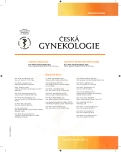Psychosocial climate in maternity hospitals from the perspective of parturients I.
Results from a national survey on perinatal care satisfactionusing a representative sample of 1195 Czech parturients
Authors:
L. Takács 1; J. Seidlerová 2
Authors‘ workplace:
Katedra psychologie FF UK, Praha, vedoucí katedry doc. PhDr. I. Gillernová, CSc.
1; II. interní klinika LF UK, Plzeň, přednosta prof. MUDr. J. Filipovský, CSc.
2
Published in:
Ceska Gynekol 2013; 78(2): 157-168
Overview
Objective:
To assess women’s satisfaction with psychosocial aspects of perinatal care provided in Czech maternity hospitals, to identify areas that need improvement and to compare satisfaction with maternity care between selected subgroups of parturients.
Design:
Original study.
Setting:
Department of Psychology, Faculty of Philosophy, Charles University, Prague.
Methods:
A survey on satisfaction with perinatal care was conducted with a sample of 1195 Czech parturients. The sample was representative of the Czech parturients’ population in terms of educational level, age, parity, and rate of vaginal and caesarean section delivery. The sample was proportionated as regards the number of births at small and large hospitals and at hospitals in different regions as well. All currently existing Czech maternity hospitals were included. For the data collection, the original Czech questionnaire KLI-P was used. The KLI-P measures psychosocial climate of maternity hospitals on following six scales: helpfulness and empathy of caregivers; control and involvement in decision-making; communication of information and availability of caregivers; dismissive attitude and lack of interest; physical comfort and services. In addition, differences in satisfaction rates between different subgroups of respondents were investigated: primiparas/multiparas, women with lower/higher educational status, women who gave birth at smaller/lager hospitals (< 800 / > 800 births per year), women who gave birth at university/other hospitals, women after vaginal delivery/caesarean section, women accommodated in high-standard rooms at after-birth unit, and women who filled the questionnaire within one year after/later than one year after delivery.
Results:
The overall satisfaction with care provided at delivery unit (DU) and after-birth unit (ABU) was 70% and 61%, respectively. The best rated scale at DU was physical comfort and services (69%), the worst evaluation score received the scale control and involvement in decision-making (34%). At ABU, the best rated scale was control and involvement in decision-making (76%) while the lowest evaluation score was found for the scale dismissive attitude and lack of interest (48% – reverse-scored). The items with the best scores referred to the cleanliness at DU and mother-infant contact at ABU, the items with the lowest evaluation scores referred to emotional support provided by physicians at DU, involvement in decision-making concerning the position during the second stage of labour and quality of food. Significantly more satisfied with care provided at DU were multiparas, women who gave birth at non-university hospitals and women who gave birth vaginally. Significantly more satisfied with care at ABU were multiparas, women with lower educational status, women who gave birth at non-university and smaller hospitals (< 800 births per year) and women who evaluated a given hospital within one year after delivery.
Conclusion:
Despite its rather high quality, the Czech perinatal care suffers from several shortcomings as regards its psychosocial aspects. These shortcomings include lack of respect and empathy shown by caregivers, poor communication of information and low involvement of parturients in decision-making. Improving the quality of care at the Czech maternity hospitals requires empowerement of parturients in the system of perinatal care and development of psychological and psychosocial compteneces of health care providers.
Keywords:
maternal-child nursing – psychosocial factors – patient satisfaction – psychosocial climate – medical psychology
Sources
1. Brown, S., Lumley, J. Satisfaction with care in labor and birth: A survey of 790 australian women. Birth, 1994, 21, p. 4–13.
2. Goodman, P., Mackey, MC., Tavakoli, AS. Factors related to childbirth satisfaction. J Adv Nurs, 2004, 46, p. 212–219.
3. Hodnett, ED. Pain and women‘s satisfaction with the experience of childbirth: A systematic review. Am J Obstet Gynecol, 2002, 186, p. 160–172.
4. Rudman, A., El-Khouri, B., Waldenström, U. Women‘s satisfaction with intrapartum care – a pattern approach. J Adv Nurs, 2007, 59, p. 474–487.
5. Sobotková, D., Štembera, Z. Psychologické aspekty v perinatální medicíně v letech 1980–2000: II. porod. Čes Gynek, 2003, 5, s. 370–372.
6. Sobotková, D., Štembera, Z. Psychologické aspekty v perinatální medicíně v letech 1980–2000: III. poporodní období. Čes Gynek, 2003, 6, s. 385–389.
7. Steiner, M. Postpartum psychiatric disorders. Can J Psychiatry, 1990, 35(1), p. 89–95.
8. Takács, L., Kodyšová, E. Psychosociální faktory ovlivňující spokojenost rodiček s perinatální péčí. Čes Gynek, 2011, 76(3), s. 199–204.
9. Takács, L., Sněhotová, J., Hoskovcová, S. Dotazník psychosociálního klimatu porodnice KLI-P. Praha: Hogrefe-Testcentrum, 2012.
10. Ústav zdravotnických informací a statistiky ČR (ÚZIS). Zpráva o rodičce 2010 [Internet]. [citováno 3.6.2012]; dostupné na http://www.uzis.cz/rychle-informace/zprava-rodicce-2010
11. Věstník MZ ČR, 2008, částka 3, kapitola 14.
12. Waldenström, U. Why do some women change their opinion about childbirth over time? Birth, 2004, 31, p. 102-107.
13. Waldenström, U., Hildingsson, I., Rubertsson, C.,Rådestad, I. A negative birth experience: prevalence and risk factors in a national sample. Birth, 2004, 31, p. 17–27.
Labels
Paediatric gynaecology Gynaecology and obstetrics Reproduction medicineArticle was published in
Czech Gynaecology

2013 Issue 2
Most read in this issue
- Transfusion-related acute lung injury (TRALI) – review
- Reccurent pregnancy loss – review
- Evaluation of p16 protein in the managementof cervical dysplasia
- Hyperlipidaemia in pregnancy
